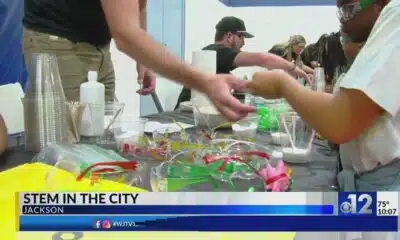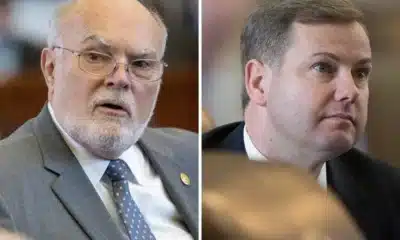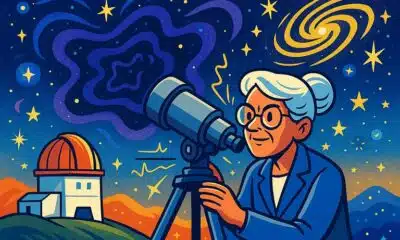Mississippi Today
My coffee-colored tap water went viral. I still don’t know what was in it.
My coffee-colored tap water went viral. I still don’t know what was in it.
On Friday, Sept. 9 – the 11th day of the water crisis in Jackson, Miss., and weeks into a citywide boil water notice – I went to brush my teeth.
I was at my apartment in Belhaven, one of the oldest and wealthiest neighborhoods in the majority-Black capital city. With the day off work, I had planned to drive to a suburb of Jackson to wash my clothes, thinking the laundromats in town were still affected by the crisis. Getting ready to leave, I turned on my bathroom sink faucet; for a second, the stream of water ran normally before it sputtered, lost pressure and turned a shockingly dark, coffee-colored brown.
My reaction was to turn off the faucet.
Earlier that week, I had seen a picture on Twitter of a bathtub, supposedly in Jackson, that was full of opaque, black water. Without more context, I had dismissed it as fake, but I wasn’t doubting anymore. I turned on my shower – it also sputtered before the water turned the same dark brown. I tried my sink again. Still brown. Then I flushed my toilet; it lurched away from the wall. I opened the lid to see chocolate-colored water slowly filling the bowl.
I took a video and posted it on Twitter with the caption, “My water just now in Jackson, MS.”
Within minutes, I was getting hundreds of retweets. That turned into dozens of direct messages, emails and phone calls from reporters around the world requesting to play the video on TV that night, and literally thousands of replies all asking the same question: What was in my water, and why was it that brown?
I had the same questions. Like all of my coworkers at Mississippi Today, I had been covering the crisis since it began on Aug. 29, but I wasn’t reporting on the condition of the water system or treatment plants.
Still, I thought I’d be well-suited to get the answers as a journalist. But more than two months later, I still don’t know what, exactly, was in my water, or why it turned brown. I've talked with experts in water quality and city officials – they gave different answers. The experts say that discolored water is a natural phenomenon in aging water systems, though the pipes in my building could've contributed. City officials are adamant my brown water was "an isolated incident," but we obtained records showing people across the city had experienced similar brown water during the height of the crisis.
The city also said they were going to test my water, but after weeks of back and forth with me, they admitted they never did.
But the first call I made that day was to my landlord’s front office. I wanted to know if other properties in Belhaven were affected or if my unit, a 1940s quadruplex, was the only one. Though the pipes in Belhaven are decades old, much of the neighborhood is downhill and nearby J.H. Fewell, the city’s secondary water plant – as a result, the homes here are often better able to weather water-related crises than those in other parts of the city.
The office manager answered the phone. Multiple properties were affected, she said. The water in Nejam Properties’ office in Belhaven Heights, a sister neighborhood on the hill across Fortification Street, was the color of “weak coffee.”
“That’s all to do with the city of Jackson and the boil water notice and stuff like that,” she said in a way that seemed intended to be reassuring.
Even before Gov. Tate Reeves declared the water emergency in a late-night press conference on Aug. 29, there was widespread confusion in Jackson about whether the water was safe to drink. Despite months of on-again, off-again boil water notices, many people, including myself, had been using the water normally. The mayor, Chokwe Antar Lumumba, had repeatedly questioned if the most recent boil water notice, which had been imposed by the state in July, was necessary.
This lack of clarity from both the city and the state continued throughout the crisis, making it hard for many Jacksonians to know what to trust. Reeves’ initial press conference did not include Lumumba or anyone from the city – and the very next day, Lumumba disputed several of Reeves’ comments, including an alarming statement that raw flood water had entered the O.B. Curtis treatment plant and was flowing into people’s homes.
In my apartment, the first clue as to what happened came a few hours after I posted the video. That afternoon, I learned my neighbor directly beneath me on the north side of the building had been getting brown water in his kitchen sink for a week if he used hot water. But on the south side, my neighbors still had clear water, albeit with low-pressure. An expert later told me this could indicate an issue with the pipes inside my section of the building – something my landlord, not the city, would be responsible for.
My water cleared up the day after I posted the video on Twitter, but it continued to gain views. By Monday, it had been watched more than 10 million times. That afternoon, I looked through my Twitter DMs.
One message stood out. It was a request from the City of Jackson’s account. They asked for my address so they could come test the water.
I could send it, I replied, but I wanted to know why they were asking.
“… If the water is that brown… we want to get the address to Public works and the health department to find the reason why,” they responded.
“Gotcha!” I wrote back before sending my address. Since I work from home, I said the city could come by any time.
“Ok…,” they wrote. “I'm going to give that address to our public works person… and hopefully they'll be able to determine what the heck is going on.”
After some back and forth, the city’s Twitter account asked if my water was still brown.
“Can we get a sample of it? (I'm asking per our public works director)”
The next morning, I ran into three city contractors on the sidewalk outside my apartment. They weren’t there to test my water but to install new meters.
I showed them the video. Gesturing down at the water meter, one of the contractors remarked that their work wouldn’t prevent the discolored water from happening again.
Jackson, he said, needs to re-pipe the whole city.
The exchange prompted me to check in with the city’s Twitter account.
“When do you think y’all will send someone over?” I asked at 9:42 a.m.
Six hours later, the city replied, “Hey Hey!!!! I think they went out there this morning…”
That was my last exchange with the city’s Twitter account, but I would learn – when I reached out to the city a month later – that Public Works never tested my water.
Meanwhile, at Mississippi Today, we were trying to do our own test of my water – an effort that proved fruitless.
Our health editor, Kate Royals, had been researching how to test water and found a private lab in Ridgeland, a suburb of Jackson, called Waypoint Analytical. We ultimately submitted three tests to Waypoint over the course of a month, for a total of $137.
The first sample, which I took the same day I posted the video, had puzzling results. That Friday afternoon, I talked to the lab manager who told me I needed to collect 100 milliliters of water and could put it in Tupperware, the only clean container I had at home. We had decided to test my water for E. coli and “total coliform,” a type of bacteria used to indicate the presence of pathogens.
The water was still dark and turbid when I turned it into the lab, but the results they sent us a few days later showed the water was too dark to test.
“The sample could not be read for Total Coliform due to the dark coloration of the sample interfering with the Reading,” the results said.
So six days later, the day the boil water notice was lifted, we tried again.
The second test came back with high levels of total coliform but no E. coli. But I had committed two possible user errors. One, my Tupperware container might’ve introduced bacteria into the sample. Two, I didn’t flush out the line by running the bathroom sink faucet before taking the sample, the water-testing protocol generally recommended by the Environmental Protection Agency.
Nearly another month passed before we could get a third and final test. This time, I got more guidelines from the lab and followed them to a tee, cleaning my faucet with bleach (which yielded more brown sediment) and running the water for one minute before collecting it in a sterile container and placing it in a bag of ice.
It came back with no bacteria detected. But that's not the full story.
One expert I later consulted, Francis de los Reyes – a professor of environmental engineering and microbiology at North Carolina State University – suggested that because the lab’s test required re-growing bacteria, the bleach I had used on the faucet could've lingered in the water, killing any organisms that might’ve been present. He said I should’ve run the tap for longer than one minute to clear the bleach.
So what was in my brown water, and why did it happen? Other experts I talked to could only speculate. De los Reyes’ colleague, Detlef Knappe, who specializes in water quality and treatment, told me that because there was likely no E. coli in my water, the brown color was probably the “natural” result of a drop in pressure in the old pipes.
In a functioning water system, Knappe explained, generators push waterfrom the plant to homes, where it stays suspended in the pipes until a faucet is turned on. But in old water systems like Jackson’s, lined with cast iron pipes, a drop in pressure can cause accumulated sediment to collapse into the disrupted water stream and turn it brown. The water isn’t leaving the plant a dark brown color, Knappe said, but becomes discolored somewhere along its journey to the faucet.
Christine Kirschoff, a professor of civil and environmental engineering at Penn State University, had another perspective. Though she agreed that the brown water was likely caused by a drop of pressure in the pipes, she said it could’ve been exacerbated by the routing of the pipes in my building. That scenario would explain why my downstairs neighbor also had discolored water but my neighbors to the south never did.
The last week of September, I went on vacation and promptly got food poisoning. I would later learn that as I was laid up on my couch – subsisting on chicken nuggets and Uncrustables and using up the last of the bottled water I’d bought the first week of the crisis – the mayor had commented on my water at a town hall the same week.
A recording of the town hall at the New Jerusalem South Church on Sept. 27 shows Lumumba, microphone in hand, standing in front of poster boards of graphs, pictures of O.B. Curtis and a spreadsheet labeled “IMMEDIATE NEEDS.” He starts talking about my water around the 12-minute mark in a tangent about re-watching an interview he gave on national TV.
By now, my tweet had helped shape the national perception of Jackson’s water crisis.
“I was upset, because I did an interview," Lumumba said. "And y’all know when I do these interviews, I can't see the packages they're running, I can't see the images that they're running in the background – all I see is a blank screen. And they keep showing this black water coming out of a faucet, right?”
My water, Lumumba went on to say, represented an “extremely rare situation” issue at “one isolated building.”
“That is not what is coming out of your water treatment facility, right?” he said. “You're not having black water going to every resident. Y'all – y'all live in Jackson. Y’all – how many times have you seen a black water come out of your faucet? Right? I have residents tell me time and time again that they don’t know where that was, right?”
For me, this raised several new questions. Did the city actually send anyone to test my water? How were they able to determine the brown water was isolated to my building? What other discussions did they have about my water? Why didn’t the city reach out to me with their conclusion?
On Oct. 13, I sent an email asking if the city had tested my water to Melissa Faith Payne, the city’s public information officer.
“I believe the discolored water at your building was an isolated incident … and not indicative of the water that actually comes from the plant,” she responded the next day. “I think it had more to do with the lines/pipes at your building. I'll Loop our public works team in to get more information for you.”
I followed up. What was the mayor’s basis for his comments at the town hall? If it was easier, I suggested, I would be happy to talk with the Public Works employee that tested my water.
“I briefed the Mayor just before the town hall,” Payne replied, adding that she was still waiting on an answer from Public Works.
About a week later, I got a statement from Jordan Hillman, the interim director of Public Works. The department could not make any employees available for an interview, she said, due to the workload of maintaining the water system, but Hillman did explain why the city thought my water was an isolated incident.
“This incident was indicative of a local pipe issue for a variety of reasons including knowledge of water condition leaving plants, water color at nearby fire hydrants, and experience with similar issues,” Hillman said. “There were extremely limited reports of similar water discoloration through our report tool.”
The tool that Hillman is referring to is an online survey the city created for residents to report the color of their water. My coworker Alex Rozier, who has been covering the crisis closely, recommended I fill it out the same day I posted the video.
I asked the experts what they thought of Hillman’s reply.
Knappe, the NC State professor, told me that the water from a fire hydrant isn’t necessarily representative of the color of water inside a home, because the pressure and speed at which water comes out of a hydrant is much greater than a faucet. Kirschoff said that it depends on where the fire hydrant that the city examined was located relative to my apartment.
Unsatisfied, I put in several public records requests. I asked for copies of any communications about my water, which the city has only partially fulfilled.
After a few more days of inquiries, Hillman finally told me that “no samples were taken from your specific home or area at that time.”
I also asked for responses to the report tool. Despite the fact that the mayor said my experience was an “extremely rare situation,” the submissions from other Jacksonian detailing discolored water seem to say otherwise. Out of565 responses, including mine, to the form since Aug. 29, 423 – or 74% – reported discolored water. The submissions came from across the city but about a third were concentrated in northeast Jackson.(We did not filter duplicates from this count.)
Responses from more than 20 people, a little more than 4%, contained descriptions of brown, gritty water that matched what I had seen in my home. Though far more people used the word "brown" to describe their water, I couldn't tell if their report matched my experience because the city was supposed to send me pictures that had been uploaded in response to the form but hasn't.
“Reddish brown water in both toilets strong enough to leave a brown ring,” one person wrote.
“When I boil my water it turn my pot brown inside my bath water have dirt in it,” another person said.
“My water is brown and leaves deposits of dirt..” a third submitted.
I asked Hillman and Payne why the city thought these responses were "extremely limited" on Nov. 4 but I haven't heard back.
More than two months after my water turned brown, I haven't had an issue. I've gone back to using my water to cook, wash my dishes, and brush my teeth, but every morning, I see reminders and warnings – representations of what could happen again. The grainy water left permanent, hair dye-like splotches on my toilet bowl, bathtub, and sink basin. Now, I always run my water for one minute before I use it.
The city and state seem to have returned to the contentious relationship that preceded the crisis, with both sides accusing the other of providing incorrect information, which only further weakens public confidence in the system.
There's no sign this will change. As winter sets in, raising the possibility that another freeze could shut down the system, the state is considering if it will lift the emergency declaration. Multiple lawsuits have been filed. And though it’ll become public soon, just last week, the city inked an agreement with the federal government to fix the water system – in secret.
This article first appeared on Mississippi Today and is republished here under a Creative Commons license.
Mississippi Today
Mississippi school superintendents indicted on fraud charges
The superintendents for Leake County and Hollandale school districts and a consultant have been indicted on four federal counts of conspiracy to commit embezzlement, theft and bribery.
According to the indictment, Earl Joe Nelson, while superintendent of Clarksdale Municipal School District and now Leake County School District, and Mario D. Willis, as superintendent of Hollandale School District, allegedly paid each other tens of thousands of dollars in school funds for consultant services that were never rendered from November 2021 until at least June 2023.
Additionally, the duo is accused of stealing U.S. Department of Education funds that were intended for their respective districts.
A St. Louis-based consultant and teacher, Moneka M. Smith-Taylor, has also been indicted on bribery charges in connection with the case. She allegedly received more than $250,000 from Willis for consulting services that were never provided over the course of two years.
She returned part of that money to Willis in the form of a cash kickback in return for the consulting contract, the indictment says.
A spokesperson for the Mississippi State Department of Education directed Mississippi Today to local school boards, who make personnel decisions for their respective districts, for comment.
The job status of the two superintendents is unclear. District officials could not be reached by presstime, but Willis is still listed as the superintendent of Hollandale School District and Nelson is still listed as the superintendent of Leake County School District in the state education department’s online directory.
It’s also unclear whether the defendants have a lawyer who could speak on their behalf.
This article first appeared on Mississippi Today and is republished here under a Creative Commons Attribution-NoDerivatives 4.0 International License.
The post Mississippi school superintendents indicted on fraud charges appeared first on mississippitoday.org
Note: The following A.I. based commentary is not part of the original article, reproduced above, but is offered in the hopes that it will promote greater media literacy and critical thinking, by making any potential bias more visible to the reader –Staff Editor.
Political Bias Rating: Centrist
The article reports on the indictment of two Mississippi school superintendents and a consultant on federal fraud charges in a straightforward, factual manner. It presents the legal allegations without editorializing or taking a stance. The language is neutral and focused on relaying verified information from the indictment and official sources, without suggesting guilt or innocence. There is no evident ideological framing or advocacy; rather, the piece sticks to reporting the details of the case and the status of the individuals involved. Thus, the article adheres to objective journalistic standards without discernible political bias.
Mississippi Today
Defendant in auditor’s ‘second largest’ embezzlement case in history goes free
Four years ago, agents from the state auditor’s office arrested Tunica nonprofit operator Mardis Jones in what the office trumpeted as the second-largest embezzlement case in its history and demanded Jones return over $1 million to the state.
The charges accused Jones of stealing $750,000 from a home rehabilitation program he was supposed to be administering while turning away needy rural residents living in crumbling houses.
But his defense attorney attacked holes in the case, and last month, a local jury found Jones not guilty of the criminal charges. Now, the state has made no indication it will bring a civil case to try to claw back the money from him.
Jones’ nonprofit Tunica County Housing Inc. secured a subcontract with the county through the North Delta Regional Housing Authority in 2014 to run the county’s home rehabilitation program funded with casino revenue. For his work, vetting applications and managing expenses, Jones earned $12,000 a month.
At the core of the criminal case were “strange money transfers” and a finding that several of the people whose applications for home rehab were approved allegedly never received any repairs to their homes. According to the auditor’s office, investigators found less than 20% of the nearly $2 million Jones’ nonprofit received went to the contractors working to rehab homes.
“Once again, an arm of government trusted a private organization to run a government program, and a large percentage of the program’s spending was flat out stolen,” State Auditor Shad White said in a press release after the arrest.
Attorney General Lynn Fitch echoed White, saying, “These funds – hundreds of thousands of dollars – were meant to help the elderly, handicapped, and poverty stricken. But the funds never got to the vulnerable citizens who needed it most.”
Jones’ lawyer Carlos Tanner explained to Mississippi Today that the program operated with an extreme backlog, and that “some of the people they were claiming didn’t get their houses done actually did” by the time the trial was held this year.
The program was poorly administered, Tanner said, meaning that even if a person’s application was approved and a rehab contract prepared, county officials could direct Jones to put someone else’s repair job ahead of his or hers.
“But just because it was run like a first weekend lemonade stand does not mean Mardis Jones stole money,” Tanner said.
Tanner said the investigators gathered paltry evidence, only looking at details that fit their narrative. While Jones did earn a large salary through his contract, Tanner said prosecutors never presented evidence that Jones converted money that was supposed to be used on home rehabilitation to his personal use.
Investigators got a warrant to seize Jones’ electronics, Tanner said, but “they never bothered to search it.”
“The two OSA (Office of the State Auditor) officials who were running the investigation, I questioned them about it during trial, and neither of them could tell me where the computer was, where the phone was, or what the contents were,” Tanner said.
Jacob Walters, a spokesperson for the auditor’s office, defended the way the investigators handled the case, saying, “The state auditor’s office is never going to turn a case we investigated over to a prosecutor unless we’re fully confident in the work that we did.”
At the time the auditor’s office announced the Jones arrest, it also said it delivered a demand letter ordering Jones to repay over $1 million, the money it alleged he stole plus interest and investigative expenses.
It’s up to the attorney general or local district attorney to decide how to prosecute auditor investigations, or in Jones’ case, what happens to the civil demand now that a jury found him not guilty in the criminal case.
When a person receives a demand alongside his or her arrest, regardless of what happens with criminal charges, the claw back can be enforced through civil litigation — much like the case against several defendants in a stunning Mississippi Department of Human Services fraud case, which began in 2020 and has yet to be resolved. Walters said the demand against Jones is still the office’s next-largest in history, second only to the welfare scandal.
The government might choose to pursue civil litigation, even if criminal prosecution is unsuccessful, because there is a lower burden of proof to win civil cases.
But the attorney general’s office told Mississippi Today last month that it had not received the Jones demand letter from the auditor, meaning it has nothing left to enforce.
Walters said the auditor’s office sent the letter along with the case file four years ago, but that with a turnover in attorneys prosecuting the case, the auditor had to resend the file last year. If the attorney general’s office no longer possesses the demand document, Walters said, “it’s an incredibly easy problem to resolve.”
“Just reach out to us with a single phone call or email and we can get it to you,” Walters said.
After the interview, the auditor’s office sent the demand letter by email, and the attorney general’s office confirmed it was received.
This article first appeared on Mississippi Today and is republished here under a Creative Commons Attribution-NoDerivatives 4.0 International License.
The post Defendant in auditor’s ‘second largest’ embezzlement case in history goes free appeared first on mississippitoday.org
Note: The following A.I. based commentary is not part of the original article, reproduced above, but is offered in the hopes that it will promote greater media literacy and critical thinking, by making any potential bias more visible to the reader –Staff Editor.
Political Bias Rating: Centrist
This article presents a factual and balanced account of the embezzlement case involving Mardis Jones without overt ideological framing. It reports statements from both government officials criticizing the alleged misconduct and the defense attorney’s rebuttals, highlighting weaknesses in the prosecution’s case. The tone remains neutral, avoiding partisan language or loaded terms. It focuses on the procedural aspects, jury verdict, and potential civil actions without advocating for a political viewpoint. The article provides context from multiple perspectives, adhering to objective reporting rather than promoting a specific ideological stance.
Mississippi Today
JPD called ICE on Miss. father, who faces deportation
Kerlin Moreno-Orellana is facing deportation over a misdemeanor charge that usually results in a fine. He was picked up by Immigration and Custom Enforcement agents on Thursday morning and transferred from the Raymond Detention Center to an ICE detention center in Louisiana.
On June 16, Jackson police arrested Moreno-Orellana, a contractor, in south Jackson along with his employer Christy Parker, who was showing him one of the old properties she worked on. Both were charged with illegal dumping, but Parker claims they did not dump anything.
After detaining them, Jackson police called a local TV outlet, 16 WAPT News, to come shoot the scene of the arrest. Parker said they were kept in the police car for over an hour, waiting for the news crew. The WAPT newsroom explained that the Jackson police routinely asks them to cover arrests related to illegal dumping or other high profile cases, in order to “dissuade people.”
Once at the station, the Jackson Police Department called ICE on the 35-year-old father of four, who had worker authorization documents. He was kept in jail overnight, while Parker was released hours after their arrest.
“He didn’t do anything I didn’t do,” Parker said in an interview with Mississippi Today. “But because I’m white, I’m here?”
A municipal court ordered Moreno-Orellana’s release the day after, but ICE placed a detainer on him – a formal request to keep a non-citizen in custody for 48 hours, while the agency investigates. It is not an arrest warrant. However, a state law passed in 2016 mandates that all local law enforcement comply with ICE detainers placed on undocumented immigrants.
“What we are doing today is no different than what we’ve always operated when the detainer is sent by ICE to the jail,” said Hinds County Sheriff Tyree Jones. “Nothing has changed.”
While the Hinds County Sheriff’s Department has historically worked with ICE, Jackson police actively seeking out ICE to detain people is a fairly recent occurrence, said Mississippi-based immigration attorney Jeremy Litton. Jackson police did not respond to a request for comment.
ICE picked up Moreno-Orellana with hours left on his detainer, and he now faces deportation. ICE spokesperson Lindsay Williams said that Moreno-Orellana violated the conditions of a past bond agreement by being arrested for a new charge. He had already spent over a month in ICE custody in 2019, after getting arrested by park rangers for speeding and driving without a license.
Still, a minor misdemeanor charge – like illegal dumping – is normally insufficient for ICE to threaten to deport someone with worker authorization paperwork. Removal of a person with documentation is usually justified if the person is deemed a threat to public safety or national security.
“This does feel like a result of the elevated focus on deporting people from the Trump administration,” said Matt Steffey, professor at the Mississippi College School of Law.
Moreno-Orellana, who is from Honduras, has three boys and a girl, the youngest of whom is less than a year old. He has lived in Mississippi for over 16 years. Colleagues describe him as a valuable worker and a good friend.
“All he ever did was work and go home,” Parker said. “He was always willing to give somebody help.”
The possibility of his deportation is leaving his family in a precarious situation. Moreno-Orellana was the sole breadwinner of the family, and his wife worries about sustaining herself and their children without him.
“I’ve always dedicated myself to taking care of my kids at home, and he’s the one who brings food to the table,” his wife said in Spanish. “I’m afraid of staying, being without my children’s father. Not so much for me, but because they need him.”
This article first appeared on Mississippi Today and is republished here under a Creative Commons Attribution-NoDerivatives 4.0 International License.
The post JPD called ICE on Miss. father, who faces deportation appeared first on mississippitoday.org
Note: The following A.I. based commentary is not part of the original article, reproduced above, but is offered in the hopes that it will promote greater media literacy and critical thinking, by making any potential bias more visible to the reader –Staff Editor.
Political Bias Rating: Center-Left
This article primarily reports on the actions of law enforcement and ICE with a focus on the human impact of deportation on a Mississippi family. While the reporting remains factual, the framing and choice of quotes highlight concerns about racial disparities, immigration enforcement policies, and potential overreach by authorities, suggesting a subtle critical tone toward current immigration enforcement practices. The article’s emphasis on the family’s hardship and the legal nuances involved positions it slightly left-of-center, sympathetic to immigrant rights and critical of aggressive ICE actions. However, it avoids overt ideological language, maintaining largely balanced coverage.
-
News from the South - Tennessee News Feed7 days ago
Thieves take thousands of dollars in equipment from Union County Soccer League
-
Mississippi Today4 days ago
Defendant in auditor’s ‘second largest’ embezzlement case in history goes free
-
News from the South - Texas News Feed6 days ago
Robert Nichols to retire from Texas Senate
-
News from the South - Louisiana News Feed6 days ago
3 lawsuits filed against CVS, Louisiana AG announces
-
News from the South - Missouri News Feed6 days ago
Residents provide feedback in Kearney Street Corridor redevelopment meeting
-
The Conversation6 days ago
The Vera C. Rubin Observatory will help astronomers investigate dark matter, continuing the legacy of its pioneering namesake
-
News from the South - Florida News Feed6 days ago
DeSantis signs bill into law that ensures public access to Florida beaches | Florida
-
News from the South - Alabama News Feed6 days ago
News 5 NOW at 12:30pm | June 24, 2025


















































